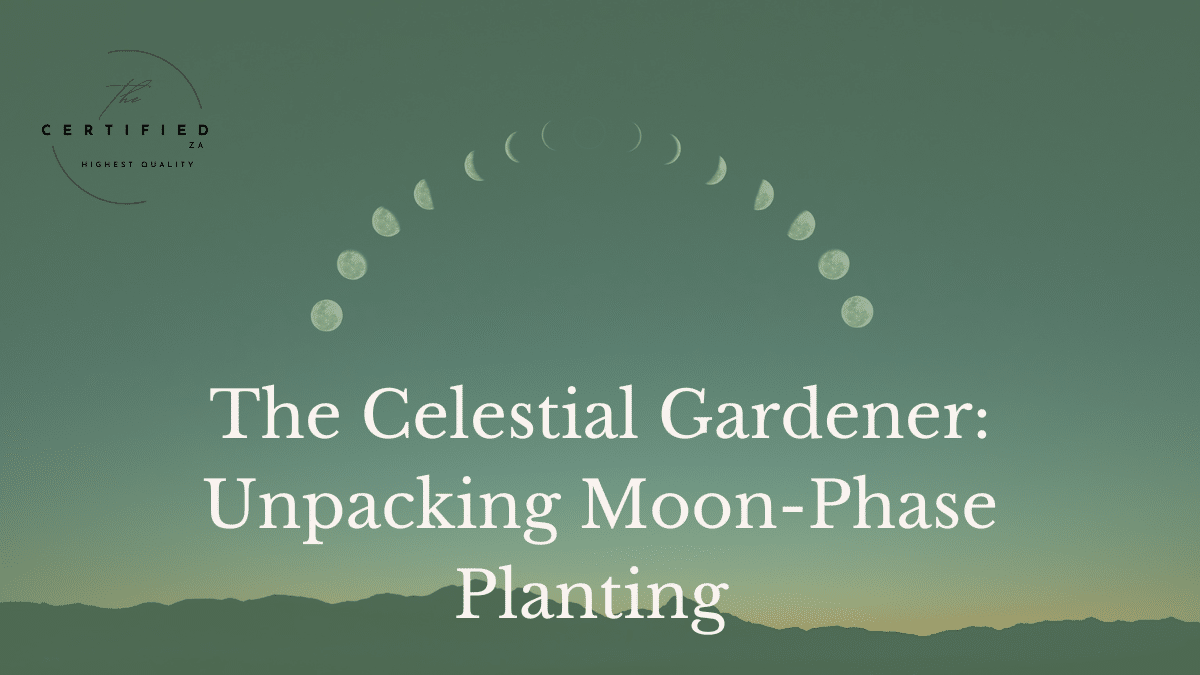
Just recently, across the vast and varied landscapes of South Africa, many of us turned our gaze skyward, captivated by the spectacle of a lunar eclipse – a “blood moon” casting its ethereal glow upon our land. Whether experienced from a mountain peak or a cosy evening picnic, the moon’s enduring power to inspire wonder and connection to the cosmos is undeniable. This deep-seated human fascination with celestial rhythms has permeated countless aspects of our lives, none more enduringly than agriculture.
Among the oldest traditions in farming is the practice of planting by the moon cycle, a method rooted in the belief that celestial phases directly influence earthly growth. For generations, from seasoned small-scale farmers in the rural heartland to ambitious commercial cultivators, observing lunar patterns has been a guiding principle for optimising planting, tending, and harvesting. In South Africa, where indigenous knowledge and ancient wisdom often intertwine with modern practices, this celestial gardening takes on a profound significance, particularly within the burgeoning cannabis industry.
Many local cannabis growers, deeply attuned to the rhythms of nature, embrace lunar planting. For some, the recent blood moon might have marked a perfect seasonal window for planting, aligning with specific energies believed to foster robust growth. For others, the anticipation builds towards the Spring equinox, a time traditionally associated with new beginnings and renewed vitality in the plant kingdom. But beyond the anecdotal observations and age-old customs, what is the underlying philosophy of moon-phase planting? And what does contemporary science, including pioneering local research, say about the moon’s subtle, yet potentially powerful, influence on our cherished cannabis plants?
In previous discussions, we’ve highlighted the scientifically validated benefits of cannabis and hemp seeds – from their rich, complete protein profiles and heart-healthy omega fatty acids to the groundbreaking discovery of rare flavoalkaloids in cannabis leaves by Stellenbosch University. These findings underscore the profound chemical complexity of the plant itself. Now, we expand this exploration to encompass an even broader, cosmic influence, examining the traditional wisdom of lunar planting, its scientific scrutiny, and what this duality means for sustainable and informed cannabis cultivation in South Africa.
The Ancient Roots of Lunar Planting: A Biodynamic Philosophy
The practice of cultivating in harmony with lunar cycles is a testament to humanity’s long-standing connection with the natural world. Civilisations across continents – from the intricate agricultural calendars of the Mayans and the ancient Egyptians to the detailed herbal wisdom of European botanists like Nicholas Culpeper – meticulously tracked the moon. These cultures believed that its gravitational pull and changing light significantly impacted everything from oceanic tides to human fertility and, crucially, the vitality of crops.
At the heart of modern moon-phase planting lies biodynamic agriculture, a holistic farming system pioneered by Rudolf Steiner in the early 20th century. Biodynamic farmers view the farm as a self-sustaining organism, intimately connected to cosmic rhythms. They believe that by aligning farming activities with the moon’s cycles, they can enhance crop yields, improve plant health, and foster deeper harmony with the environment. This approach is not merely about avoiding synthetic inputs, as in organic farming, but about actively engaging with the subtle forces believed to govern life on Earth.
The core premise of lunar planting rests on two primary, yet largely unproven, mechanisms:
- Gravitational Influence: It is believed that the moon’s gravitational pull, similar to its effect on ocean tides, subtly influences the movement of water and nutrients within plants – their sap flow. This “tidal effect” within plants is thought to stimulate different growth patterns depending on the moon’s position relative to Earth and the Sun.
- Light Cycles: The varying intensity of moonlight across the lunar cycle is considered an environmental cue that can stimulate different physiological responses in plants, such as germination, leaf growth, or root development.
These beliefs drive a meticulous approach to agricultural planning, where every task, from sowing to harvesting, is scheduled according to the moon’s journey through the sky.
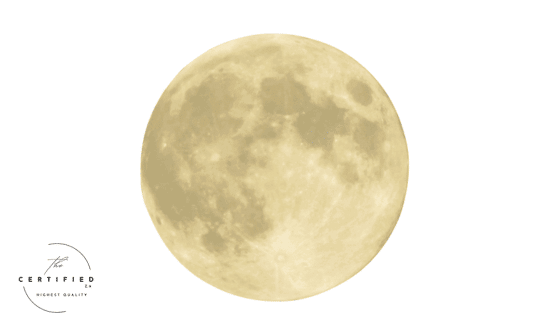
The Lunar Calendar for Cannabis: Traditional Cultivation Strategies
For cannabis cultivators embracing biodynamic principles, the moon phases transform into a living, dynamic calendar, guiding specific tasks to optimise plant health and potential yield. While cannabis’s growth cycle is predominantly influenced by photoperiod (light/dark cycles) for flowering, traditional lunar planting offers a complementary framework for enhancing overall plant vitality.
Here’s how these age-old traditions translate into practical advice for cultivating cannabis, often adapted for specific growth goals:
- The Waxing Moon (New Moon to Full Moon): Encouraging Above-Ground Vigour
As the moon visibly grows from a faint crescent to a full disk, this period is traditionally associated with increasing lunar energy and an upward energetic pull.
- Above-Ground Growth: This phase is considered optimal for planting seeds or clones intended for robust vegetative growth, encouraging energy to be directed towards lush foliage and strong stems. The belief is that the increasing light and gravitational pull stimulate sap flow, enhancing seed germination, initial root establishment, and overall plant development. For cannabis, this translates to focusing on vegetative growth, fostering healthy, vigorous shoots and leaves.
- Grafting: The rising sap during the waxing phase is also thought to improve the success rate of grafting, as the plant’s enhanced vitality is believed to aid graft establishment. This could be relevant for cannabis growers looking to propagate specific strains or create multi-strain plants.
- The Full Moon: Peak Energy and Flowering Signals
The night of the full moon is often seen as a pinnacle of lunar influence, with maximum light intensity and gravitational pull.
- Optimal Sowing: This day is traditionally considered favourable for sowing seeds, believed to promote higher germination rates and stronger initial growth. For cannabis, this aligns with starting seeds for vigorous plants.
- Flowering and Fruiting: For some plants, the increased light of the full moon may act as an environmental cue, potentially influencing flowering and fruiting cycles. While cannabis flowering is primarily initiated by changes in daily light exposure (photoperiod), traditional growers might view the full moon as a supportive element, enhancing the plant’s reproductive phases.
- Pruning Avoided: Pruning is generally avoided around the full moon, as the plant’s sap is believed to be at its highest, potentially leading to excessive bleeding and slower healing.
- The Waning Moon (Full Moon to New Moon): Root Development and Storage Focus
As the moon appears to shrink from full to a thin crescent, this phase is linked to decreasing lunar energy and a shift in focus towards below-ground growth.
- Root Enhancement: This period is considered ideal for activities that promote strong root development. For cannabis, this might mean focusing on root-boosting applications or, if growing for specific root biomass (though less common for cannabis), encouraging subterranean growth. The reduced light and receding gravitational pull are thought to encourage energy to be directed downwards to the root systems, improving nutrient absorption and overall plant stability.
- Transplanting and Pruning: The waning moon is considered an ideal time for transplanting, as the downward energy flow is believed to reduce transplant shock and promote quicker re-establishment. Pruning is also recommended during this phase, as the receding sap is thought to promote quicker healing of cut surfaces.
- Harvesting for Preservation: Harvesting crops intended for long-term storage is traditionally done during the waning moon, as the plant’s sap is believed to be concentrated in the roots, potentially leading to better preservation of the harvested material.
- Ascending vs. Descending Moon: Influencing Sap Flow and Development
Beyond the monthly phases, some biodynamic calendars incorporate whether the moon is “ascending” (moving higher in the sky each day) or “descending” (moving lower).
- Ascending Moon: Believed to promote an upward sap flow and stimulate shoot development. This period is considered apt for aerial agricultural activities such as grafting, layering, and harvesting above-ground parts. For cannabis, this would correspond to periods of strong vegetative growth.
- Descending Moon: Thought to encourage downward sap flow and root activity. This time is considered ideal for planting root crops, transplanting, and general soil work, believed to enhance nutrient uptake in the root zone.
- Node Days and Perigee/Apogee:
- Node Days: These occur when the moon crosses the path of the sun (when eclipses are possible). They are generally considered disruptive and unfavourable for most farming activities.
- Perigee (Moon Closest to Earth): When the moon is closest, its gravitational pull is strongest. This period is often associated with enhanced fungal diseases and is advised against for sowing due to increased susceptibility.
- Apogee (Moon Farthest from Earth): This period, when the moon’s gravitational pull is weakest, is considered ideal for harvesting, storage of crops, and composting.
6. Zodiac Rhythms: Highly intricate biodynamic calendars also integrate the moon’s passage through the 12 zodiac constellations. Specific constellations (grouped by elements like Fire, Water, Earth, or Air) are linked to different crop types (fruit/seed, leafy, tuber/soil, flower), guiding targeted activities for cannabis and other plants.
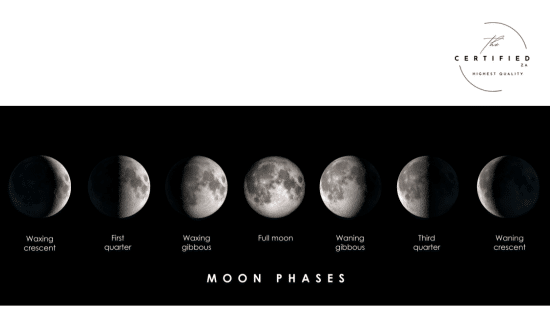
Under the Gaze of Science: Scrutinizing Lunar Influence
While the traditional wisdom of moon-phase planting is deeply ingrained in agricultural lore, modern science approaches these claims with rigorous empirical scrutiny. A comprehensive review of physics and biology textbooks, alongside peer-reviewed literature, often presents a more reserved and frequently sceptical perspective on the moon’s direct physiological influence on plants.
The paper “What Has Been Thought and Taught on the Lunar Influence on Plants in Agriculture? Perspective from Physics and Biology” by Mayoral, Solbes, Cantó, and Pina provides a critical scientific framework. Their extensive review highlights the disconnect between popular agricultural beliefs and established scientific evidence regarding lunar effects on plant growth [Mayoral et al. 2020].
- The Folly of Gravitational Forces on Plants:
- Miniscule Gravitational Pull: From a purely physical standpoint, the moon’s gravitational pull on Earth’s surface is approximately 3.3 × 10⁻⁵ m/s², which is nearly 300,000 times lower than Earth’s own gravity. While the moon’s differential gravitational pull is the primary driver of ocean tides, this force is extremely weak on individual plants.
- Imperceptible Effect on Plant Fluids: The tidal acceleration exerted by the moon on a small, individual object like a 2-metre-tall plant is calculated to be a minuscule 3 × 10⁻¹³ m/s² [Mayoral et al. 2020]. This value is “completely imperceptible” and insufficient to induce any significant movement or flow in plant sap, which is governed by much stronger internal capillary forces, osmotic pressure, and transpiration pull.
- Tidal Mismatch: Even if lunar gravity did affect sap flow in plants, oceanic tides occur twice daily, whereas biodynamic practices link sap movement to the monthly lunar phases (waxing/waning). This fundamental mismatch further undermines the gravitational hypothesis for lunar-phase planting.
- Moonlight: A Faint Glow with Limited Impact:
- Extremely Low Illuminance: Moonlight, even at its brightest during a full moon, is incredibly dim compared to sunlight. It provides, at best, 0.25 lux, which is 128,000 to 400,000 times lower than the minimum sunlight on an average day [Mayoral et al. 2020].
- Insufficient for Photosynthesis: This minimal light intensity is generally considered “not a significant source of energy for photosynthesis.” Plants primarily rely on direct, high-intensity solar radiation for their energy production. Studies have shown that full moonlight PAR (photosynthetically active radiation) is inadequate for photosynthetically supported growth [Breitler et al. 2020].
- Stress, Not Stimulus: Interestingly, recent research on Coffea arabica plants indicates that while plants can perceive full moonlight (as blue light), this weak illumination acts more as a “stress factor” than a growth stimulant. It has been shown to influence the transcription of genes related to photosynthesis and chloroplast machinery, suggesting a perception of stress rather than beneficial growth [Breitler et al. 2020].
- Limited Impact on Flowering: While some night-blooming species may use moonlight as a cue, scientific consensus suggests it’s unlikely to significantly influence flowering in most plants due to its low intensity. Early work on polarised moonlight and germination by Semmens showed some limited effects, but later studies found these effects negligible due to the extremely small polarization levels [Mayoral et al. 2020].
- Other Proposed Influences: Unsubstantiated Claims:
- Lunar Magnetic Fields: Theories suggesting that lunar magnetic fields influence plant growth are also largely unsubstantiated by direct scientific evidence. The moon’s current magnetic field is negligible compared to Earth’s own geomagnetic field, and any proposed effect would be minuscule and has not been conclusively proven to affect plant biology directly [Mayoral et al. 2020].
- Atmospheric Tides: While the moon’s gravity does cause subtle “atmospheric tides” affecting wind patterns, these are considered minor compared to solar influences and lack direct correlation to plant physiological responses as claimed by biodynamic practices [Mayoral et al. 2020].
In summary, the comprehensive scientific review by Mayoral et al. unequivocally states that “to date Moon has not been proved to affect plant biology regarding consolidated physics” [Mayoral et al. 2020]. The logical consequence is that direct lunar effects on plant physiology are generally absent from standard physics and biology reference handbooks.
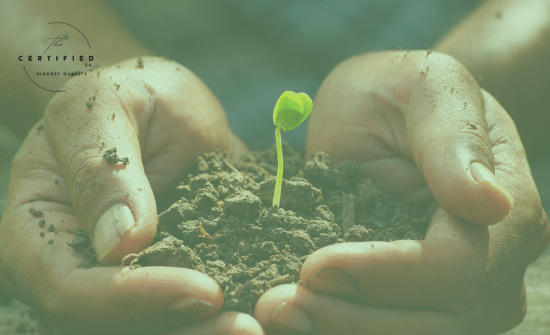
Bridging the Divide: Observations, Science, and the Future of Cannabis
The scientific discourse often finds itself at odds with generations of agricultural observations. While Mayoral et al. conclude there’s no strong scientific backing for direct lunar influence, other studies, like the review by Sivasankari and Thimmaiah, acknowledge that biodynamic farmers do report observable positive correlations [Sivasankari & Thimmaiah, 2021]. These include enhanced seed germination, increased yields in crops like barley, oats, carrots, and radishes, and even improved quality of phytoconstituents in Ashwagandha when harvested during full moon periods.
This discrepancy highlights a critical point: while a direct, physics-based causal mechanism from the moon to plant physiology remains largely unproven, the holistic practice of biodynamic farming, which incorporates lunar cycles, often involves meticulous observation, deep soil stewardship, and a general attentiveness to nature. These indirect factors—optimized soil health, reduced pest pressure due to stronger plants, and careful timing of tasks—could be responsible for the reported positive outcomes, regardless of a direct lunar force. The commitment to working with nature, as often found in biodynamic approaches, can intrinsically lead to improved yields and plant vitality.
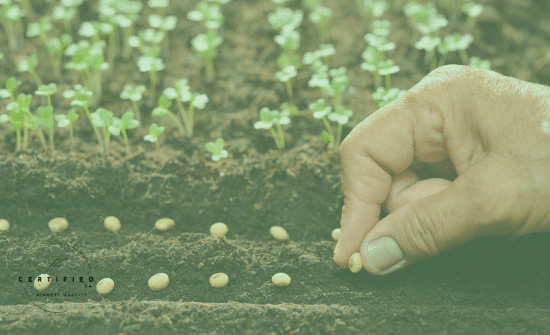
Implications for Cannabis Cultivation in South Africa:
This dual perspective—respecting traditional observations while seeking scientific understanding—is particularly vital for South Africa’s rapidly growing cannabis industry:
- Respecting Cultural Heritage: In a country rich with diverse cultural practices, dismissing traditional lunar planting outright would be short-sighted. These traditions often embody valuable, time-tested practices of land stewardship and careful observation that contribute to healthy ecosystems. For cannabis growers, embracing the discipline of lunar calendars, even without explicit scientific causation for direct lunar forces, can foster meticulous planning and a deeper connection to their land.
- Leveraging Intrinsic Plant Benefits: The scientifically validated benefits of cannabis and hemp seeds – from their complete protein and healthy fats to the groundbreaking discovery of rare flavoalkaloids in the leaves by Stellenbosch University – are inherent to the plant itself. These intrinsic qualities are a constant, robust foundation for cultivation, regardless of celestial alignments. The Stellenbosch research, uncovering new compounds within cannabis leaves, is a powerful example of how deep scientific inquiry into the plant’s own chemistry continues to yield astonishing results, offering tangible, science-backed avenues for product development.
- The Need for Local, Controlled Research: The scientific community, including Project Alpha and Sivasankari & Thimmaiah, calls for more rigorous, region-specific studies. For South African cannabis growers, this means an opportunity to participate in controlled trials that compare lunar-phase planting with conventional methods, meticulously monitoring not just yields but also cannabinoid and terpene profiles, flavoalkaloid content, and other plant physiological responses. Such local research, conducted with scientific rigour, can provide evidence-based guidance, validating or refining traditional practices in our unique climates and soil conditions.
- Informed Cultivation for Sustainability: By balancing traditional wisdom with scientific insights, South African cannabis cultivators can adopt a truly informed approach. This involves integrating the proven benefits of proper soil management, nutrient cycling, pest control, and optimal strain selection (informed by chemical analyses like those from Stellenbosch University) with the meticulous planning offered by lunar calendars. The result is a more sustainable, resilient, and potentially more productive cultivation system that respects both the earthly and celestial rhythms.
The recent blood moon, a moment of collective awe, reminds us that the universe is full of mysteries. As South African scientists continue to lead the way in uncovering the plant’s chemical secrets, and our agricultural community explores its rhythms, we move closer to a future where cannabis is cultivated, understood, and cherished for its profound and multifaceted potential – a true gift from both Earth and sky. This journey, blending ancient wisdom with cutting-edge science, promises not only healthier crops but a deeper, more sustainable connection to our world.
